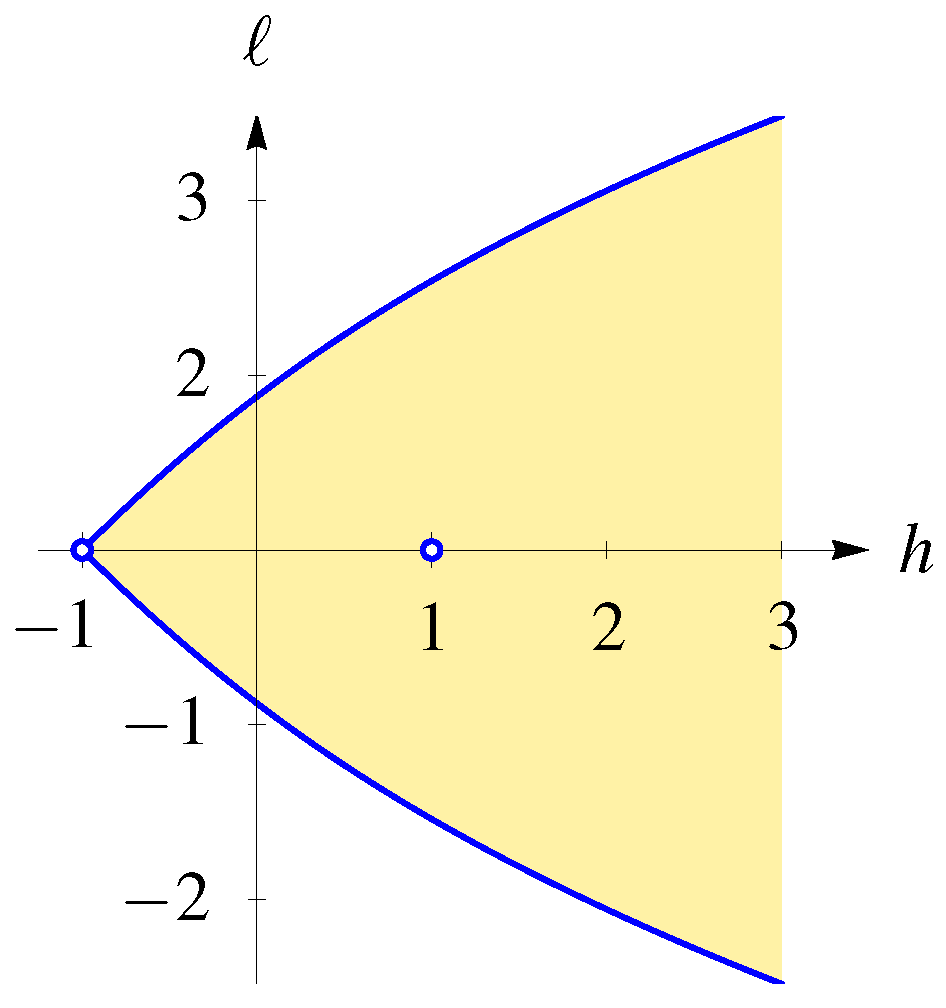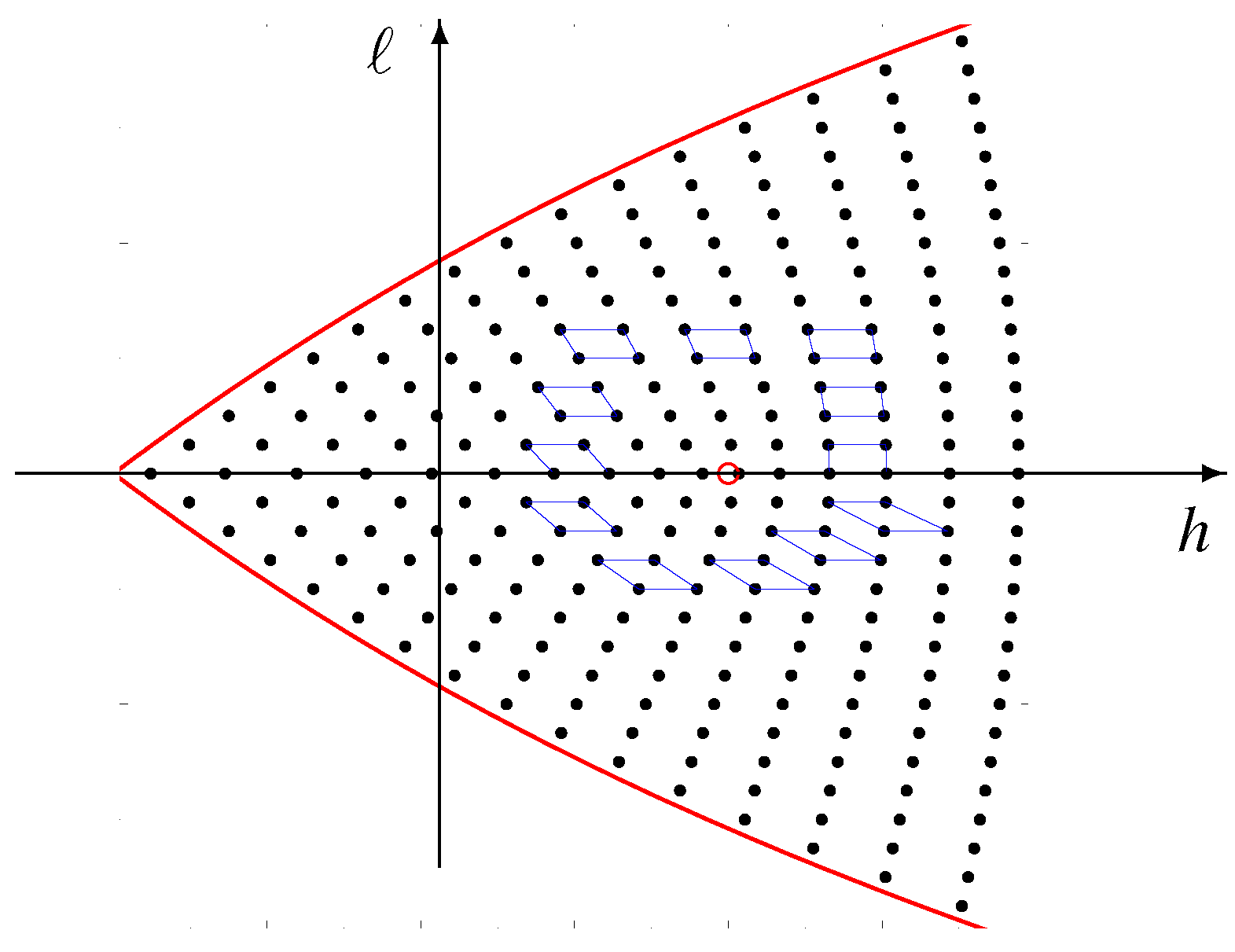Classical and Quantum Spherical Pendulum
Abstract
:1. Introduction
2. The Classical Spherical Pendulum
2.1. The Basic System
2.2. Reduction of Symmetry
2.3. Regular Values
- (1)
- The set of regular values is the top 2-dimensional stratum. Here, for is a smooth 2-dimensional torus.
- (2)
- The two curves , excluding the point , are two 1-dimensional strata. Here, for is a smooth circle.
- (3)
- There are two 0-dimensional strata: the points and . Here, is a point; while is an immersed 2-sphere in with one normal crossing, in other words, a once pinched 2-torus.
2.4. Action–Angle Coordinates
- 1.
- The symplectic form on when restricted to is exact and .
- 2.
- The actions and are smooth functions of H and L on .
- 3.
- The vector field is Hamiltonian on , corresponding to the Hamiltonian . Moreover, the integral curves of satisfy
2.5. Properties of the Functions , and
- 1.
- 2.
- Atthe functionhas a jump discontinuity. Specifically, for
- 3.
- The functionis multivalued. Along any positively oriented closed curve, which generates the fundamental group of, its value decreases by 1.
- 4.
- The functionis real analytic and even in ℓ, namely,. Moreover,asandas.
2.6. Additional Properties of
- 1.
- has a nonnegative continuous extension to , which vanishes on . Additionally, , and .
- 2.
- Let for some . Then, the functionis strictly increasing.
- 3.
- Let . The a-level set of in is the graph of a continuous, piecewise real analytic functionwhich is strictly decreasing when , is strictly increasing when and has a positive minimum value at .
2.7. The Period Lattice and Its Degeneration
2.8. Monodromy
3. Quantum Spherical Pendulum
3.1. Elements of Geometric Quantization
3.1.1. The Prequantization Line Bundle
3.1.2. Bohr–Sommerfeld Conditions
3.1.3. Prequantization Operators
3.2. Bohr–Sommerfeld Polarization
3.3. Bohr–Sommerfeld Quantization
3.4. Bohr–Sommerfeld–Heisenberg Quantization
3.4.1. Shifting Operators
3.4.2. Quantization of Angles
3.4.3. Boundary Conditions
3.5. Quantum Monodromy
- 1.
- discuss the definition of quantum monodromy;
- 2.
- show that the quantum spherical pendulum has quantum monodromy;
- 3.
- read off the classical monodromy of the spherical pendulum from the joint spectrum of its Bohr–Sommerfeld–Heisenberg quantization.
- 1.
- encircles the point ;
- 2.
- passes consecutively throught the verticesof the spectral quadrilaterals , , , .
4. Concluding Remarks
- We have extended the Bohr–Sommerfeld quantization of the spherical pendulum to a full quantum theory, which we call the Bohr–Sommerfeld–Heisenberg (BSH) quantization. Our approach leads to a matrix formulation of Born, Jordan and Heisenberg [10,11] with quantum operators expressed as matrices in the Bohr–Sommerfeld basis. According to Mehra and Rechenberg ([21], p. 265) the connection between quantum mechanics and the Bohr–Sommerfeld theory of multiply periodic systems “seems to have been lost completely in the matrix approach” until it was re-established by Wentzel [22].
- We had an advantage of being able to rely on the guiding principle of geometric quantization for an open dense subset of the phase space in which all our constructions were regular. In treating nowhere dense sets of singular points, we followed Dirac’s Principles of Quantum Mechanics [13].
- In our presentation, we have included the geometric quantization setting of the Schrödinger theory. It shows that the main difference between the BSH theory and the Schrödinger theory is the choice of polarization. For a completely integrable system, the energy–momentum map is regular in an open dense subset of the phase space. Hence, in the BSH quantization, we have to deal with polarization with singularities on the boundary of that set. This leads to difficulties analogous to those that appear in formulating the Schrödinger theory on a singular space.
- In the case of the spherical pendulum, the Bohr–Sommerfeld energy spectrum differs from the Schrödinger energy spectrum. In the quasiclassical limit of ℏ close to zero, the Bohr–Sommerfeld spectrum and the Schrödinger spectrum of differ by .
- In physics, Planck’s constant is approximately joules. However, in the process of quantization, ℏ is treated as a parameter. In the Schrödinger quantization, the representation space is independent of ℏ, while the quantum operators depend on ℏ explicitly. In the BSH quantization, presented here, the representation space depends on ℏ because it is defined in terms of a basis consisting of eigensections supported on fibers of the energy–momentum map that satisfy the Bohr–Sommerfeld conditions. For every fiber of the energy–momentum map, there exists a value of ℏ, treated as a parameter, for which this fiber satisfies Bohr–Sommerfeld conditions.
- For every , where , our construction gives well-defined shifting operators and their adjoints on the representation space . It is a consequence monodromy that the interpretation of the shifting operators as the quantization of and fails to be global even on the set of regular values of the energy–momentum map.
Author Contributions
Funding
Institutional Review Board Statement
Informed Consent Statement
Conflicts of Interest
References
- Bohr, N. On the constitution of Atoms and Molecules. Philos. Mag. 1913, 26, 1–25. [Google Scholar] [CrossRef] [Green Version]
- Sommerfeld, A. Zur Theorie der Balmersschen Series. Sittzungberichte der Mathematisch-Physikalischen Klasse de K.B. Akademie der Wissenschaften zu München. 1915, pp. 459–500. Available online: https://www.zobodat.at/pdf/Sitz-Ber-Akad-Muenchen-math-Kl_1915_0425-0458.pdf (accessed on 21 February 2022).
- Eckert, M. How Sommerfeld extended Bohr’s model of the atom (1913–1916). Eur. Phys. J. H 2014, 39, 141–156. [Google Scholar] [CrossRef]
- Del Valle, J.C.; Turbinger, A.V. Power-like potentials: From Bohr-Sommerfeld energies to exact ones. arXiv 2021, arXiv:2108.00327v2. [Google Scholar] [CrossRef]
- Cushman, R.; Śniatycki, J. Bohr-Sommerfeld-Heisenberg theory in geometric quantization. J. Fixed Point Theory Appl. 2013, 13, 3–24. [Google Scholar] [CrossRef] [Green Version]
- Cushman, R.; Śniatycki, J. On Bohr-Sommerfeld-Heisenberg quantization. J. Geom. Symmetry Phys. 2014, 35, 11–19. [Google Scholar]
- Cushman, R.; Duistermaat, J.J. The quantum mechanical spherical pendulum. Bull. AMS 1988, 19, 475–479. [Google Scholar] [CrossRef] [Green Version]
- Śniatycki, J. Geometric Quantization and Quantum Mechanics; Springer: New York, NY, USA, 1980. [Google Scholar]
- Heisenberg, W. Über die quantentheoretische Undeutung kinematischer und mechanischer Beziehungen. Z. Für Phys. 1925, 33, 879–893. [Google Scholar] [CrossRef]
- Born, M.; Jordan, P. Zur Quantenmechanik. Z. Für Phys. 1925, 34, 858–888. [Google Scholar] [CrossRef]
- Born, M.; Heisenberg, W.; Jordan, P. Zur Quantenmechanik II. Z. Phys. 1925, 35, 557–615. [Google Scholar] [CrossRef]
- Schrödinger, E. Quantisierung als Eigenwert Problem. Ann. Phys. 1926, 79, 361–378; 489–527. [Google Scholar] [CrossRef]
- Dirac, P.A.M. The Principles of Quantum Mechanics; Clarendon Press: Oxford, UK, 1930. [Google Scholar]
- Cushman, R.; Śniatycki, J. Shifting operators in geometric quantization. Axioms 2020, 9, 125. [Google Scholar] [CrossRef]
- Cushman, R.H.; Bates, L.M. Global Aspects of Classical Integrable Systems, 2nd ed.; Birkhäuser: Basel, Switzerland, 2015. [Google Scholar]
- Richter, P.; Dullin, H.; Waalkens, H.; Wiersig, J. Spherical pendulum, actions, and spin. J. Phys. Chem. 1996, 100, 19124–19135. [Google Scholar] [CrossRef] [Green Version]
- Blattner, R.J. Quantization in representation theory. In Harmonic Analysis on Homogeneous Spaces; Taam, E.T., Ed.; American Mathematical Society: Providence, RI, USA, 1973; Volume 26, pp. 146–165. [Google Scholar]
- Ward, D.W.; Volkmer, S. How to Derive the Schrödinger Equation. arXiv 2006, arXiv:0610121v1. [Google Scholar]
- Vu Ngoc, S. Quantum monodromy in integrable systems. Commun. Math. Phys. 1999, 203, 465–479. [Google Scholar] [CrossRef]
- Hirzebruch, F. Topological Methods in Algebraic Geometry; Grundlehren der Math. Wiss.; Springer: New York, NY, USA, 1966; Volume 131. [Google Scholar]
- Mehra, J.; Rechenberg, H. The Historical Development of Quantum Theory; Springer: New York, NY, USA, 1982; Volume 2. [Google Scholar]
- Wentzel, G. Die mehrfach periodischen Systeme in der Quantenmechanik. Z. Für Phys. 1926, 37, 80–94. [Google Scholar] [CrossRef]





| B | |||||||
|---|---|---|---|---|---|---|---|
| 0 | 1 | 0 | 0 | 0 | |||
| 0 | 0 | 0 | 0 | 0 | |||
| 0 | 0 | 0 | |||||
| 0 | 0 | 0 | 0 | ||||
| 0 | 0 | 0 | 0 | ||||
| 0 | 0 | 0 | 0 | 0 | 0 | ||
| A |
| B | |||||
|---|---|---|---|---|---|
| 0 | 0 | ||||
| 0 | 0 | ||||
| 0 | 0 | ||||
| 0 | 0 | 0 | 0 | ||
| A |
| B | ||||
|---|---|---|---|---|
| 0 | ||||
| 0 | ||||
| 0 | ||||
| A |
Publisher’s Note: MDPI stays neutral with regard to jurisdictional claims in published maps and institutional affiliations. |
© 2022 by the authors. Licensee MDPI, Basel, Switzerland. This article is an open access article distributed under the terms and conditions of the Creative Commons Attribution (CC BY) license (https://creativecommons.org/licenses/by/4.0/).
Share and Cite
Cushman, R.; Śniatycki, J. Classical and Quantum Spherical Pendulum. Symmetry 2022, 14, 496. https://doi.org/10.3390/sym14030496
Cushman R, Śniatycki J. Classical and Quantum Spherical Pendulum. Symmetry. 2022; 14(3):496. https://doi.org/10.3390/sym14030496
Chicago/Turabian StyleCushman, Richard, and Jędrzej Śniatycki. 2022. "Classical and Quantum Spherical Pendulum" Symmetry 14, no. 3: 496. https://doi.org/10.3390/sym14030496
APA StyleCushman, R., & Śniatycki, J. (2022). Classical and Quantum Spherical Pendulum. Symmetry, 14(3), 496. https://doi.org/10.3390/sym14030496





